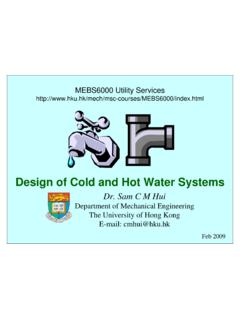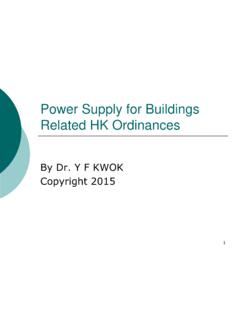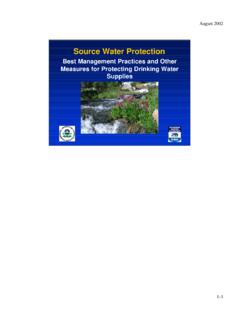Transcription of Session 3: Design of Cold and Hot Water Systems
1 MEBS6000 Utility Services Dr. Benjamin Ho Department of Mechanical Engineering The University of Hong Kong E-mail: Session 3: Design of cold and Hot Water Systems Sept. 2010 Contents for this Session Design principles Water demand Water storage Pipe sizing Pipe materials Pump Systems Other considerations 2 Design principles Common Water supply Systems cold Water system Potable Water Flushing Water (fresh or salt Water ) Non-potable Water Cleansing Water fire service Swimming pool filtration Irrigation ( for landscape) Fountain circulation Air-conditioning Water , etc. Hot Water system ( in hotels & hospitals) 3 Design principles Major tasks of Water Systems Design : 1. Assessment & estimation of demands 2. supply scheme & schematic 3. Water storage requirements 4. Piping layout 5. Pipe sizing 6. Pump system Design The Systems must comply with Water Authority (WSD) requirements 4 Design principles General principles for installing plumbing works (from WSD Plumbing Installation Handbook) All Water fittings and pipework shall comply with the relevant Waterworks Regulations All plumbing works shall be carried out in accordance with the Hong Kong Waterworks Requirements All plumbing works shall be carried out by a licensed plumber System main pipes should preferably not be run through the individual premises 5 Design principles Building (Standards of Sanitary Fitments, Plumbing, Drainage Works and Latrine) Regulations (Law of Hong Kong CAP123) Identifies the population and required sanitary fitments in the premise plus Practice Notes for Authorized Persons, Registered Structural Engineers and Registered Geotechnical Engineers (PNAP) Amendment of the regulations as necessary 6 Design Proposal Plumbing proposal (vetted by WSD)
2 A block plan in a scale of 1:1000 showing the location and boundary of the development The locations should be marked with datum level A plan showing the alignment and size of the proposed connection pipes from the main to the development A plan showing the proposed alignment and size of the internal underground Water pipes to be laid in the development Vertical plumbing line diagrams 7 (Source: ) Example of a plumbing system schematic (fresh & flushing Water supplies) Use of fresh Water for flushing Direct Feed for Potable Indirect Feed for Flushing (no Direct Feed allowed) 8 (Source: ) Example of plumbing layout Design 9 Design principles Plumbing proposal (cont d) A schedule containing the following items :- (a) number of flats/units in each block of the building (b) address of each premise needs individually metered Water supply (c) number of draw-off points and sanitary fittings in each unit (d) estimated daily consumption for all trade purposes Meters arranged in meter rooms & fittings at the meter positions The relevant standards for the pipe materials to be used Capacities of the Water storage tanks roof storage tanks 10 Water demand Water demand depends on: Type of building & its function Number of occupants, permanent or transitional Requirement for fire protection Systems Landscape & Water features Typical appliances using the cold Water WC cistern, wash basin, bath, shower, sink Washing machine, dishwasher Urinal flushing cistern 11 Water demand Theoretical framework: Probability Theory Based on statistics & a binomial distribution Pm = probability of occurrence.
3 N = total number of fittings having the same probability m = number of fitting in use at any one time Probability factor of a particular number of draw off points occurring at any one time is: P = (t / T) t = time of appliance filling T = time between successive usage of the appliance mnmmPPmnmnP )1()!(!!12 (Source: IOP, 2002. Plumbing Engineering Services Design Guide) Probability graph Example: 100 appliances each take 30s Water consumption each time, and are used at a frequency of 1200 s (20 min) P = t / T = 30/600 = Using the graph, only 7 out of the 100 appliances will be in use at any one time. 13 Water demand Simultaneous demand Most fittings are used only at irregular intervals It is unlikely that all the appliances will be used simultaneously No need to size pipework on continuous maximum Key factors to consider: Capacity of appliance (L) Draw-off flow rate (L/s) Draw-off period, or time taken to fill appliance (sec) Frequency of use, time between each use (sec) 14 Water demand Loading Unit ( ) A factor given to an appliance relating the flow rate at its terminal fitting to Length of time in use Frequency of use for a particular type Use of building Evaluate the probable maximum Relates the flow rate to the probable usage Also, consider Design & minimum flow rates 15 Design flow rates and loading units Outlet fitting Design flow rate (l/s) Minimum flow rate (l/s) Loading units WC flushing cistern single or dual flush (to fill in 2 min.)
4 2 WC trough cistern per WC 2 Wash basin tap size -DN 15 per tap Spray tap or spray mixer per tap --- Bidet per tap 1 Bath tap, -DN 20 10 Bath tap, 1-DN 25 22 Shower head (will vary with type of head) hot or cold 3 Sink tap, -DN 15 3 Sink tap, -DN 20 5 Washing machine size DN 15 hot or cold --- Dishwasher size DN 15 3 Urinal flushing cistern per position --- (Source: Garrett, R. H., 2008. Hot and cold Water supply ) 16 Water demand Apply probability theory, with caution Assume random usage with fittings (is this true?) Determine max. frequencies of use Estimate average Water usage rates & time The theory is valid with large nos. of fittings Often expect to be exceeded at 1% time only (99% confidence level) Reliability and risk management (what is the consequence) Need to understand the context/circumstance Is it similar to average/typical? (* adjust data if needed) Any foreseeable special requirements?
5 17 Water demand Design flow considerations A small increase in demand over Design level will cause a slight reduction in pressure/flow (unlikely to be noticed by users) Exceptional cases, such as: Cleaners sinks (depends on one s behavior) Urinal flushing cisterns (continuous small flow) Team changing rooms at sport clubs (high demand) Special events (ad hoc demand) 18 19 Relationship between Loading Unit and the respective flow rate (L/s) equivalent to = 7 L/s (not 13L/s) (Source: Plumbing Engineering Services Design Guide) Water storage Purposes of Water storage Provide for an interruption of supply Accommodate peak demand Provide a pressure (head) for gravity supplies Design factors Type and number of fittings Frequency and pattern of use Likelihood and frequency of breakdown of supply (often Design for 12- or 24-hour reserve capacity) Water storage requirements in Hong Kong to follow WSD recommendations 20 Recommended minimum storage of cold and hot Water Systems Type of building Minimum cold Water storage (litres) Minimum hot Water storage (litres) Hostel 90 per bed space 32 per bed space Hotel 200 per bed space 45 per bed space Office premises: - with canteen facilities - without canteen facilities 45 per employee 40 per employee per employee per employee Restaurant 7 per meal per meal Day school.
6 - nursery or primary - secondary or technical 15 per pupil 20 per pupil per pupil per pupil Boarding school 90 per pupil 23 per pupil Children s home or residential nursery 135 per bed space 25 per bed space Nurses home 120 per bed space 45 per bed space Nursing or convalescent home 135 per bed space 45 per bed space (Source: Garrett, R. H., 2008. Hot and cold Water supply ) Note: Minimum cold Water storage shown includes that used to supply hot Water outlets. 21 Estimation of cold Water storage per occupant Type of building Storage per occupant (litres) Factories (no process) 10 Hospitals, per bed 135 Hospitals, per staff on duty 45 Hostels 90 Hotels 135 Houses and flats 135 Offices with canteens 45 Offices without canteens 35 Restaurant (* per meal) 7 Schools, boarding 90 Schools, day 30 (Source: ) 22 Estimation of hot Water consumption Type of building Consumption per occupant (litres/day) Peak demand per occupant (litres/hr) Storage per occupant (litres) Factories (no process) 22 45 9 5 Hospitals, general 160 30 27 Hospitals, mental 110 22 27 Hostels 90 45 30 Hotels 90 160 45 30 Houses and flats 90 160 45 30 Offices 22 9 5 Schools, boarding 115 20 25 Schools, day 15 9 5 (Source.)
7 23 Fixtures Water requirements (demand at individual Water outlets) Type of fixture Flow rate (litres/min) Minimum supply pressure (kPa) Bathtub faucet 19 55 Bidet 28 Laundry machine 15 55 Lavatory faucet, ordinary 55 Lavatory faucet, self closing 10 55 Shower head 19 55 Shower, temperature controlled 10 138 Sink 3/8", 1/2" 17 55 Sink 3/4" 23 55 Urinal flush valve 56 110 Water closet with flush valve 132 170 Water closet with gravity tank 10 55 (Source: ) 24 Fixtures, cold Water storage, hot Water consumption & flow rate Type of fixture cold Water storage capacity (litres) Hot Water consumption (litre/hr) Hot Water flow rate (litre/s) Basin (private) 90 14 Basin (public) 90 45 Bath 900 90 180 Garden Water tap 180 --- --- Shower 450 900 180 Sink 90 45 90 Urinal 180 --- --- WC 180 --- --- (Source: ) 25 Quantity of flushing Water required User Average demand Domestic buildings 450 L per number of required soil fitment per day (WSD 45L per point) Offices, factories, department stores, shops, public buildings and other nondomestic buildings of a like nature 450 L per number of required soil fitment per day (WSD 45L per point) Restaurants L per seat per day Cinemas litres per seat per day Schools 18 litres per head per day Hotels and boarding houses 90 litres per room per day (Source: Buildings Department PNAP APP-4, Dec 2005) 26 (Source: Garrett, R.)
8 H., 2008. Hot and cold Water supply ) Heat input for Water (kW) Dwelling with 1 bath Dwelling with 2 baths* With stratification litres With mixing litres With stratification litres With mixing litres 3 109 122 165 260 6 88 88 140 200 10 70 70 130 130 15 70 70 120 130 Hot Water storage vessel minimum capacities Note: * Maximum requirement of 150 litre drawn off at 60 C (2 baths plus 10 litre for kitchen use) followed by a further bath (100 litre at 40 C) after 30 min. 27 System Arrangements Direct supply Indirect supply sump and pump supply system cascade sump and pump supply system pneumatic booster supply system variable speed pumping supply system top floor boosting supply system gravity supply system Note that the overall system may include one or more of the above system arrangements 28 29 Top Floor Boosting System Gravity supply System Sump & Pump System Direct supply System Note: Kitchen Exhaust System and other non-potable Systems demand an indirect system due to possible contamination of the mains supply Pipe sizing Correct pipe sizes will ensure adequate flow rates at appliances and avoid problems, Oversized Pipework Additional & unnecessary installation costs Delays in obtaining hot Water at outlets Increased heat losses from hot Water pipes Undersized Pipework Inadequate delivery from outlets Variation and fluctuation in temperature & pressure at outlets ( showers and other mixers) Increase in noise levels For small, simple installations, pipes are often sized based on experience & convention 30 (Source: Garrett, R.
9 H., 2008. Hot and cold Water supply ) Available head (from cistern) = vertical distance in metres from Water line in cistern to point under consideration Available head (mains supply ) = head at main minus height above main = 20 m 4 m = 16 m head 1 m head = kPa = mbar 31 Pipe sizing Pipe sizing procedure (a) Determine the flow rate: 1) by using loading units ( ) then convert to flow (L/s) 2) for continuous flow (L/s) 3) obtain the Design flow rate (L/s) by adding 1) and 2) (b) Determine the effective pipe length: 4) work out the measured pipe length (m) 5) work out the equivalent pipe length for fittings 6) work out the equivalent pipe length for draw-offs 7) obtain the effective pipe length (m) by adding 4), 5) & 6) 32 Pipe sizing Pipe sizing procedure (cont d) (c) Calculate the permissible loss of head: 8) determine the available head (mH) 9) determine the head loss per effective length (mH/m run) through pipes (d) Determine the pipe diameter: 10) decide the pipe diameter through fundamental equations or by pipe charts 11) check against common Design figures Head Loss = run Flow velocity < 3m/s for gravity feed Flow velocity < 6m/s for pumped feed 33 (Source: Garrett, R.
10 H., 2008. Hot and cold Water supply ) Example of use of loading units Required Design flow (from graph) = L/s + = L/s How about urinals? continuous 34 Take note that in HK, flush Water and potable Water are separate Systems (Source: Garrett, R. H., 2008. Hot and cold Water supply ) Example of measured & effective pipe lengths Measured pipe length = m Equivalent pipe lengths: elbows 2 x = m tee 1 x = m stopvalve 1 x = m taps 2 x = m check valves 2 x = m Effective pipe length = m 35 (Source: Garrett, R. H., 2008. Hot and cold Water supply ) Equivalent pipe lengths (copper, stainless steel and plastics) Bore of pipe (mm) Equivalent pipe length (m) Elbow Tee Stopvalve Check valve 12 20 25 32 40 50 65 --- --- 73 --- Nominal size of tap Flow rate (l/s) Head loss (m) Equiv. pipe length (m) G1/2- DN 15 G1/2- DN 15 G3/4- DN 20 G1- DN 25 36 (Source: Garrett, R.






